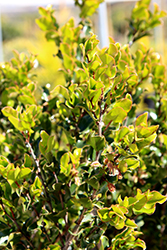Fri & Sat 8am - 8pm
Sun 8am - 7pm
Anytown, USA 12345
fax: 261.787.0463
e-mail: info@successgc.com


Plant Finder

Height: 15 feet
Spread: 8 feet
Sunlight:
![]()
![]()
Hardiness Zone: 9b
Other Names: Bladder Nut, African Snowdrop Bush, Glossy Box
Brand: San Marcos Growers
Description:
A large shrub or small tree with smooth, dark gray bark and attractive, very glossy, dark green leaves; creamy bell flowers appear in spring, and fruit capsules only if there are male and female plants; tolerates pruning well
Ornamental Features
Black-bark features dainty lightly-scented creamy white bell-shaped flowers along the branches from early to mid spring. It has attractive dark green evergreen foliage which emerges chartreuse in spring. The glossy oval leaves are highly ornamental and remain dark green throughout the winter. It produces brick red capsules from early to late summer. The smooth dark gray bark and brick red branches are extremely showy and add significant winter interest.
Landscape Attributes
Black-bark is an open multi-stemmed evergreen shrub with an upright spreading habit of growth. Its average texture blends into the landscape, but can be balanced by one or two finer or coarser trees or shrubs for an effective composition.
This shrub will require occasional maintenance and upkeep, and should only be pruned after flowering to avoid removing any of the current season's flowers. It is a good choice for attracting bees and butterflies to your yard. It has no significant negative characteristics.
Black-bark is recommended for the following landscape applications;
- Accent
- Mass Planting
- Hedges/Screening
- General Garden Use
- Topiary
- Container Planting
Planting & Growing
Black-bark will grow to be about 15 feet tall at maturity, with a spread of 8 feet. It has a low canopy with a typical clearance of 1 foot from the ground, and is suitable for planting under power lines. It grows at a medium rate, and under ideal conditions can be expected to live for 60 years or more. This is a dioecious species, meaning that individual plants are either male or female. Only the females will produce fruit, and a male variety of the same species is required nearby as a pollinator.
This shrub does best in full sun to partial shade. It is very adaptable to both dry and moist growing conditions, but will not tolerate any standing water. It is considered to be drought-tolerant, and thus makes an ideal choice for xeriscaping or the moisture-conserving landscape. This plant will benefit from an application of bonemeal and/or mycorrhizal fertilizer at the time of planting. It is not particular as to soil pH, but grows best in sandy soils. It is somewhat tolerant of urban pollution, and will benefit from being planted in a relatively sheltered location. This species is not originally from North America. It can be propagated by cuttings.
Black-bark makes a fine choice for the outdoor landscape, but it is also well-suited for use in outdoor pots and containers. Its large size and upright habit of growth lend it for use as a solitary accent, or in a composition surrounded by smaller plants around the base and those that spill over the edges. It is even sizeable enough that it can be grown alone in a suitable container. Note that when grown in a container, it may not perform exactly as indicated on the tag - this is to be expected. Also note that when growing plants in outdoor containers and baskets, they may require more frequent waterings than they would in the yard or garden.
